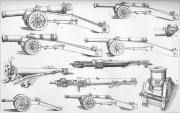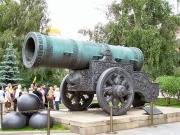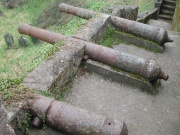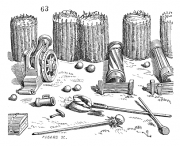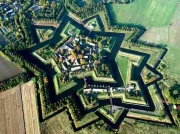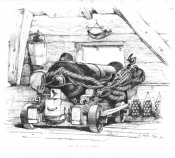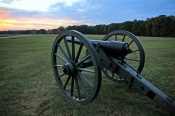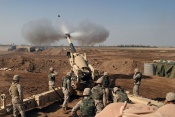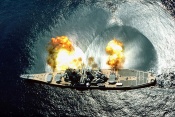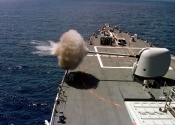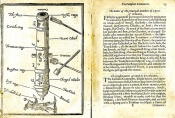Cannon
A cannon is a type of artillery, usually large and tubular, that uses gunpowder or other explosive-based propellants to launch a projectile over a distance. Cannon vary in caliber, range, mobility, rate of fire, angle of fire, and firepower; different forms of cannon combine and balance these attributes in varying degrees, depending on their intended use on the battlefield. The word cannon is derived from several languages, in which the original definition can usually be translated as tube, cane, or reed.
First used in China, cannon were among the earliest forms of gunpowder artillery, and over time replaced siege engines—among other forms of aging weaponry—on the battlefield. The first hand cannon appeared during the Battle of Ain Jalut between the Egyptians and Mongols in the Middle East. The first cannon in Europe were probably used in Iberia, during the Reconquista between Muslims and Christians, in the 13th century. English cannon were first used during the Hundred Years' War, at the Battle of Crécy, in 1346. It was during this period, the Middle Ages, that cannon became standardized, and more effective in both the anti-infantry and siege roles. After the Middle Ages, most large cannon were abandoned, in favor of greater numbers of lighter, more maneuverable pieces. In addition, new technologies and tactics were developed, making most defenses obsolete; this led to the construction of star forts, specifically designed to withstand artillery bombardment and the associated siege tactics.
Cannon also transformed naval warfare: the Royal Navy, in particular, took advantage of their firepower. As rifling became more commonplace, the accuracy of cannon was significantly improved, and they became deadlier than ever, especially to infantry. In World War I, a considerable majority of all deaths were caused by cannon; they were also used widely in World War II. Most modern cannon are similar to those used in the Second World War, with the exception of naval guns, which are now significantly smaller in caliber. In particular, autocannon have remained nearly identical to their World War II counterparts.
Contents |
[edit] Etymology and terminology
Cannon is derived from the Old Italian word cannone, meaning large tube, which came from Latin canna, in turn originating from the kanna,—Greek for cane, or reed—and ultimately deriving from the Akkadian term qanu, meaning tube or reed.[1] The word has been used to refer to a gun since 1326 in Italy, and 1418 in England. Cannon serves both as the singular and plural of the noun, although the plural cannons is also correct.
Any large, smoothbore, muzzle-loading gun—used before the advent of breech-loading, rifled guns—may be referred to as a cannon, though the term specifically refers to a gun designed to fire a 42-pound (19 kg) shot, as opposed to a demi-cannon,—32 pounds (15 kg)—culverin,—18 pounds (8.2 kg)—or demi-culverin—9 pounds (4.1 kg). Gun specifically refers to a type of cannon that fires projectiles at high velocities, and usually in relatively flat angles;[2] they have been used in warships extensively, and as field artillery, as well. The term cannon also applies to the autocannon, a modern gun with a with a high rate of fire. Autocannon have been used extensively in fighter aircraft since World War II,[3] and are sometimes used on land vehicles.[4]
[edit] History
- For more details on the historical use of gunpowder in general, see History of gunpowder.
[edit] Early history

The earliest known cannon was invented by Ctesibius of Alexandria, in the 3rd century BC. Little is known about this primitive invention—as most of Ctesibius' works were lost—but it was noted by Philo of Byzantium that it operated using compressed air. One of the first cannon used in battle was the fire lance, a gunpowder-filled tube attached to the end of a spear and used as a flamethrower. Shrapnel was sometimes placed in the barrel, so that it would fly out along with the flames. Eventually, the paper and bamboo of which fire lance barrels were originally constructed came to be replaced by metal. The earliest known depiction of a firearm is a sculpture from a cave in Sichuan, dating to the 12th century, that portrays a figure carrying a vase-shaped bombard, firing flames and a cannonball. The oldest surviving gun, dated to 1288, has a muzzle bore diameter of 2.5 cm (1 in); the second oldest, dated to 1332, has a muzzle bore diameter of 10.5 cm (4 in).
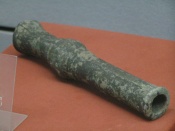
The first documented battlefield use of gunpowder artillery took place on January 28, 1132, when Song General Han Shizhong used huochong to capture a city in Fujian. The first known illustration of a cannon is dated to 1326. In his 1341 poem, The Iron Cannon Affair, one of the first accounts of the use of gunpowder artillery in China, Xian Zhang wrote that a cannonball fired from an eruptor could "pierce the heart or belly when it strikes a man or horse, and can even transfix several persons at once."
Joseph Needham suggests that the proto-shells described in the Huolongjing may be among the first of their kind. The Chinese also mounted over 3,000 cast bronze and iron cannon on the Great Wall of China, to defend themselves from the Mongols. The weapon was later taken up by both the Mongol conquerors and the Koreans. Chinese soldiers fighting under the Mongols appear to have used hand cannon in Manchurian battles during 1288, a date deduced from archaeological findings at battle sites.
In the 1593 Siege of Pyongyang, 40,000 Ming troops deployed a variety of cannon to bombard an equally large Japanese army. Despite both forces having similar numbers, the Japanese were defeated in one day, due to the Ming advantage in firepower. Throughout the Seven Year War in Korea, the Chinese-Korean coalition used artillery widely, in both land and naval battles.
[edit] Islamic world
- see also: Great Turkish Bombard
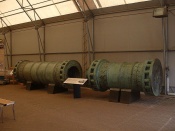
Portable hand cannon ("midfa," in Arabic) were first used by the Egyptians to repel the Mongols at the Battle of Ain Jalut in 1260, and again in 1304. The composition of the gunpowder used in these battles was later described in several manuscripts, written in the early 14th century. Four different mixtures were used, the most explosive having a composition (74% saltpeter, 11% sulfur, 15% carbon) almost identical to modern gunpowder (75% saltpeter, 10% sulfur, 15% carbon). These mixtures were more explosive than those used in either China or Europe during this period.[5][6] The Battle of Ain Jalut also saw the use of the earliest known gunpowder cartridges, employed by the Egyptians in their fire lances and hand cannon.
The use of cannon as siege machines dates back to Abu Yaqub Yusuf, who employed them at the siege of Sijilmasa, in 1274, according to Ibn Khaldun. Also intended for siege warfare, the first supergun, the Great Turkish Bombard, was used by the troops of Mehmed II to capture Constantinople, in 1453. Urban, a Hungarian cannon engineer, is credited with the invention of this cannon. It had a 762 mm (30 in) bore, and could fire 544 kg (1,200 lb) stones a mile, and the sound of their blast could reportedly be heard from a distance of 10 miles (16 km). The Great Turkish Bombards were cast in bronze and made in two parts: the chase and the breech, which, together, weighed 16 tonnes. The two parts were screwed together using levers to facilitate the work.
Another weapon invented in the Islamic world, fashioned for killing infantry, was the first known autocannon. It was invented in the 16th century, by Fathullah Shirazi, a Persian-Indian polymath and mechanical engineer, who worked for Akbar the Great in the Mughal Empire. As opposed to the polybolos and repeating crossbows used earlier in Ancient Greece and China, respectively, Shirazi's rapid-firing machine had multiple gun barrels that fired hand cannon.
[edit] Medieval Europe
In Europe, the first mention of gunpowder's composition in express terms appeared, in Roger Bacon's "De nullitate magiæ" at Oxford, published in 1216. Later, in 1248, his "Opus Maior" describes a recipe for gunpowder and recognized its military use:
"We can, with saltpeter and other substances, compose artificially a fire that can be launched over long distances ... By only using a very small quantity of this material much light can be created accompanied by a horrible fracas. It is possible with it to destroy a town or an army ... In order to produce this artificial lightning and thunder it is necessary to take saltpeter, sulfur, and Luru Vopo Vir Can Utriet."
The first confirmed use of gunpowder in Europe was the Moorish cannon, first used by the Andalusians in the Iberian Peninsula, at the siege of Seville in 1248, and the siege of Niebla in 1262. By this time, hand guns were probably in use, as scopettieri—"gun bearers"—were mentioned in conjunction with crossbowmen, in 1281. In Iberia, the "first artillery-masters on the Peninsula" were enlisted, at around the same time.

The first metal cannon was the pot-de-fer. Loaded with an arrow-like bolt that was probably wrapped in leather to allow greater thrusting power, it was set off through a touch hole with a heated wire. This weapon, and others similar, were used by both the French and English during the Hundred Years' War, when cannon saw their first real use on the European battlefield. While still a relatively rarely-used weapon, cannon were employed in increasing numbers during the war. "Ribaldis," which shot large arrows and simplistic grapeshot, were first mentioned in the English Privy Wardrobe accounts during preparations for the Battle of Crécy, between 1345 and 1346. The Florentine Giovanni Villani recounts their destructiveness, indicating that by the end of the battle, "the whole plain was covered by men struck down by arrows and cannon balls." Similar cannon were also used at the Siege of Calais, in the same year, although it was not until the 1380s that the "ribaudekin" clearly became mounted on wheels.
The first cannon appeared in Russia around 1380, though they were used only in sieges, often by the defenders. Around the same period, the Byzantine Empire began to accumulate its own cannon to face the Ottoman threat, starting with medium-sized cannon 3 feet (0.91 m) long and of 10 in caliber. The first definite use of artillery in the region was against the Ottoman siege of Constantinople, in 1396, forcing the Ottomans to withdraw. They acquired their own cannon, and laid siege to the Byzantine capital again, in 1422, using "falcons," which were short but wide cannon. By 1453, the Ottomans used 68 Hungarian-made cannon for the 55-day bombardment of the walls of Constantinople, "hurling the pieces everywhere and killing those who happened to be nearby." The largest of their cannon was the Great Turkish Bombard, which required an operating crew of 200 men and 70 oxen, and 10,000 men to transport it. Gunpowder made the formerly devastating Greek fire obsolete, and with the final fall of Constantinople,—which was protected by what were once the strongest walls in Europe—on May 29, 1453, "it was the end of an era in more ways than one."
[edit] Early modern period
By the 1500s, cannon were made in a great variety of lengths and bore diameters, but the general rule was that the longer the barrel, the longer the range. Some cannon made during this time had barrels exceeding 10 ft (3.0 m) in length, and could weigh up to 20,000 pounds (9,100 kg). Consequently, large amounts of gunpowder were needed, to allow them to fire stone balls several hundred yards. By mid-century, European monarchs began to classify cannon to reduce the confusion. Henry II of France opted for six sizes of cannon,[7] but others settled for more; the Spanish used twelve sizes, and the English sixteen.[8] Better powder had been developed by this time as well. Instead of the finely ground powder used by the first bombards, powder was replaced by a "corned" variety of coarse grains. This coarse powder had pockets of air between grains, allowing fire to travel through and ignite the entire charge quickly and uniformly.
The end of the Middle Ages saw the construction of larger, more powerful cannon, as well their spread throughout the world. As they were not effective at breaching the newer fortifications resulting from the development of cannon, siege engines—such as siege towers and trebuchets—became less widely used. However, wooden "battery-towers" took on a similar role as siege towers in the gunpowder age—such as that used at siege of Kazan in 1552, which could hold ten large-caliber cannon, in addition to 50 lighter pieces. Another notable effect of cannon on warfare during this period was the change in conventional fortifications. Niccolò Machiavelli wrote, "There is no wall, whatever its thickness that artillery will not destroy in only a few days." Although castles were not immediately made obsolete by cannon, their use and importance on the battlefield rapidly declined. Instead of majestic towers and merlons, the walls of new fortresses were thicker, angulated, and sloped, while towers became lower and stouter; increasing use was also made of earthen, brick, and stone breastworks and redoubts. These new defenses became known as "star forts," after their characteristic shape. A few of these featured cannon batteries, such as the Tudors' Device Forts, in England. Star forts soon replaced castles in Europe, and, eventually, those in the Americas, as well.
By the end of the 15th century, several technological advancements were made, making cannon more mobile. Wheeled gun carriages and trunnions became common, and the invention of the limber further facilitated the transportation of artillery. Manucy, p. 5.</ref> As a result, field artillery became viable, and began to emerge, often used alongside the larger cannon intended for sieges. The better gunpowder, improved, cast-iron projectiles, and the standardization of calibers meant that even relatively light cannon could be deadly. In The Art of War, Niccolò Machiavelli observed that "It is true that the arquebuses and the small artillery do much more harm than the heavy artillery." This was the case at Flodden, in 1513: the English field guns outpaced the Scottish siege artillery, firing twice, or even thrice, as many rounds. Despite the increased maneuverability, however, cannon were still much slower than the rest of the army: a heavy English cannon required 23 horses to transport, while a culverin, nine, yet, even with this many animals transporting them, they still moved at a walking pace. Due to their relatively slow speed, and lack of organization, discipline, and tactics, the combination of pike and shot still dominated the battlefields of Europe.
Innovations continued, notably the German invention of the mortar, a thick-walled, short-barreled gun that blasted shot upward at a steep angle. Mortars were useful for sieges, as they could fire over walls and other defenses.[9] This cannon found more use with the Dutch, who learned to shoot bombs filled with powder from them. However, setting the bomb fuse in the mortar was a problem. "Single firing" was the first technique used to set the fuse, where the bomb was placed with the fuse down against the propelling charge. This practice often resulted in the fuse being blown into the bomb, causing it to blow up in front of the mortar. Because of this danger, "double firing" was developed, where the fuse was turned up and the gunner lighted the fuse and the touch hole simultaneously. This, however, required much skill and timing, and was especially dangerous when the gun failed to fire, leaving a lighted bomb in the barrel. Not until 1650 was it accidentally discovered that double-lighting was a superfluous process: the heat of firing was enough to light the fuse.
Gustavus Adolphus of Sweden emphasized the use of light cannon and mobility in his army, and created new formations and tactics that revolutionized artillery. He discontinued using all 12 pounder—or heavier—cannon as field artillery, preferring, instead, to use cannon that could be manned by only a few men. One gun, called the "leatheren," could be serviced by only two persons, but was abandoned, replaced by 4 pounder and 9 pounder demi-culverins. These could be operated by three men, and pulled by only two horses. Also, Adolphus's army was the first to use a special cartridge that contained both powder and shot, which sped up loading, and therefore increased the rate of fire. Additionally, he pioneered the use of canister shot against infantry, which was essentially a can, filled with musket balls. At the time, for each thousand infantrymen, there was one cannon on the battlefield; Gustavus Adolphus increased the number of cannon in his army so dramatically, that there were six cannon for each one thousand infantry. Each regiment was assigned two pieces, though he often decided to arrange his artillery into batteries, instead. These were to destroy the enemy's infantry, while his cavalry outflanked their heavy guns.
At the Battle of Breitenfeld, in 1631, Adolphus proved the effectiveness of the changes made to his army, in particular his artillery, by defeating Johann Tserclaes, Count of Tilly. Although severely outnumbered, the Swedes were able to fire between three and five times as many volleys of artillery without losing ground, due to their infantry's linear formations. Battered by cannon fire, and low on morale, Tilly's men broke rank, and fled.
Around this time also came the idea of aiming the cannon to hit a target. Gunners controlled the range of their cannon by measuring the angle of elevation, using a "gunner's quadrant." Cannon did not have sights, therefore, even with measuring tools, aiming was still largely guesswork.
In the latter half of the 17th century, the French engineer Vauban introduced a more systematic and scientific approach to attacking gunpowder fortresses, in a time when many field commanders "were notorious dunces in siegecraft." Careful sapping forward, supported by enfilading ricochet fire, was a key feature of this system, and it even allowed Vauban to calculate the length of time a siege would take. He was also a prolific builder of star forts, and did much to popularize the idea of "depth defense" in the face of cannon These principles were followed into the mid-19th century, when changes in armaments necessitated greater depth defense than Vauban had provided for. It was only in the years prior to World War I that new works began to break radically away from his designs.
[edit] 18th and 19th centuries
The lower tier of 17th-century English ships of the line were usually equipped with demi-cannon, guns that fired a 32 pounds (15 kg) solid shot, and could weigh up to 3,400 pounds (1,500 kg). Demi-cannon were capable of firing these heavy metal balls with such force, that they could penetrate more than a meter of solid oak, from a distance of 90 m (300 ft), and could dismast even the largest ships at close range. Full cannon fired a 42 lb (19 kg) shot, but were discontinued by the 18th century, as they were too unwieldy. By the end of the century, principles long adopted in Europe specified the characteristics of the Royal Navy's cannon, as well as the acceptable defects, and their severity. The United States Navy tested guns by measuring them, firing them two or three times,—termed "proof by powder"—and using pressurized water to detect leaks.
The carronade was adopted by the Royal Navy in 1779; the lower muzzle velocity of the round shot when fired from this cannon was intended to create more wooden splinters when hitting the structure of an enemy vessel, as they were believed to be deadly. The carronade was much shorter, and weighed between a third to a quarter less than an equivalent long gun; for example, a 32 pounder carronade weighed less than a ton, compared with a 32 pounder long gun, which weighed over 3 tons. The guns were, therefore, easier to handle, and also required less than half as much gunpowder, allowing fewer men to crew them.[10] Carronades were manufactured in the usual naval gun calibers,[11] but were not counted in a ship of the line's rated number of guns. As a result, the classification of Royal Navy vessels in this period can be misleading, as they often carried more cannon than were listed.
In the 1810s and 1820s, greater emphasis was placed on the accuracy of long-range gunfire, and less on the weight of a broadside. The carronade, although initially very successful and widely adopted, disappeared from the Royal Navy in the 1850s, after the development of steel, jacketed cannon, by William George Armstrong and Joseph Whitworth. Nevertheless, carronades were used in the American Civil War.[12]
The Great Turkish Bombards of the Siege of Constantinople, after being on display for four centuries, were used to battle a British fleet in 1807, in the Dardanelles Operation. The artillery hit a British ship with two 700 lb (320 kg) cannonballs, killing 60 sailors; in total, the cannon claimed over 100 lives, prompting the British to retreat. In 1867, Sultan Abdul Aziz gifted Queen Victoria the 17-ton "Dardanelles Gun," one of the cannon used at the siege of Constantinople.
In contrast to these antiquated weapons, Western cannon during the 19th century became larger, more destructive, more accurate, and could fire at longer range. One example is the American 3 in (76 mm) wrought-iron, muzzle-loading howitzer, used during the American Civil War, which had an effective range of over 1.1 mi (1.8 km). Another is the smoothbore 12 pounder Napoleon, which was renowned for its sturdiness, reliability, firepower, flexibility, relatively light weight, and range of 1,700 m (5,600 ft).
Cannon were crucial in Napoleon Bonaparte's rise to power, and continued to play an important role in his army in later years. During the French Revolution, the unpopularity of the Directory led to riots and rebellions. When over 25,000 of these royalists—led by General Danican—assaulted Paris, Paul François Jean Nicolas, vicomte de Barras was appointed to defend the capital; outnumbered five to one and disorganized, the Republicans were desperate. When Napoleon arrived, he reorganized the defenses, while realizing that without cannon, the city could not be held. He ordered Joachim Murat to bring the guns from the Sablons artillery park; the Major and his cavalry fought their way to the recently captured cannon, and brought them back to Napoleon. When Danican's poorly trained men attacked, on 13 Vendémiaire, 1795—October 5, 1795, in the calendar used in France, at the time—Napoleon ordered his cannon to fire grapeshot into the mob, an act that became known as the ""whiff of grapeshot." The slaughter effectively ended the threat to the new government, while, at the same time, made Bonaparte a famous—and popular—public figure. Among the first generals to recognize that artillery was not being used to its full potential, Napoleon often massed his cannon into batteries, and introduced several changes into the French artillery, improving it significantly, and making it among the finest in Europe. Baynes, p. 669.</ref> Such tactics were successfully used by the French, for example, at the Battle of Friedland, when sixty-six guns fired a total of 3,000 roundshot, and 500 grapeshot, inflicting severe casualties to the Russian forces, whose losses numbered over 20,000 killed and wounded, in total. At the Battle of Waterloo,—Napoleon's final battle—the French army had many more artillery pieces than either the British or Prussians. As the battlefield was muddy, recoil caused cannon to bury themselves into the ground after firing, resulting in slow rates of fire, as more effort was required to move them back into an adequate firing position; also, roundshot did not ricochet with as much force from the wet earth. Despite the drawbacks, sustained artillery fire proved deadly during the engagement, especially during the French cavalry attack. The British infantry, having formed infantry squares, took heavy losses from the French guns, while their own cannon fired at the cuirassiers and lancers, when they fell back to regroup. Eventually, the French ceased their assault, after taking heavy losses from the British cannon and musket fire.
The practice of rifling—casting spiraling lines inside the cannon's barrel—was applied to artillery more frequently by 1855, as it gave cannon gyroscopic stability, which improved their accuracy. One of the earliest rifled cannon was the Armstrong gun,—also invented by William George Armstrong—which boasted significantly improved range, accuracy, and power than earlier weapons. The projectile fired from the Armstrong gun could reportedly pierce through a ship's side, and explode inside the enemy vessel, causing increased damage, and casualties. The British military adopted the Armstrong gun, and was impressed; the Duke of Cambridge even declared that it "could do everything but speak." Despite being significantly more advanced than its predecessors, the Armstrong gun was rejected soon after its integration, in favor of the muzzle-loading pieces that had been in use before. While both types of gun were effective against wooden ships, neither had the capability to pierce the armor of ironclads; due to reports of slight problems with the breeches of the Armstrong gun, and their higher cost, the older muzzle-loaders were selected to remain in service, instead. Realizing that iron was more difficult to pierce with breech-loaded cannon, Armstrong designed rifled muzzle-loading guns, which proved successful; The Times reported: "even the fondest believers in the invulnerability of our present ironclads were obliged to confess that against such artillery, at such ranges, their plates and sides were almost as penetrable as wooden ships."
The superior cannon of the Western world brought them tremendous advantages in warfare. For example, in the Opium War in China, during the 19th century, British battleships bombarded the coastal areas and fortifications from afar, safe from the reach of the Chinese cannon. Similarly, the shortest war in recorded history, the Anglo-Zanzibar War of 1896, was brought to a swift conclusion by shelling from British battleships. The cynical attitude towards recruited infantry in the face of ever more powerful field artillery is the source of the term cannon fodder, first used by François-René de Chateaubriand, in 1814; however, the concept of regarding soldiers as nothing more than "food for powder" was mentioned by William Shakespeare as early as 1598, in Henry IV, Part 1.
[edit] 20th and 21st centuries
Cannon in the 20th and 21st centuries are usually divided into sub-categories, and given separate names. Some of the most widely used types of modern cannon are howitzers, mortars, guns, and autocannon, although a few superguns—extremely large, custom-designed cannon—have also been constructed. Nuclear artillery were experimented with, but were abandoned as impractical.[13] Modern artillery is used in a variety of roles, depending on its type. According to NATO, the general role of artillery is to provide fire support, which is defined as "the application of fire, coordinated with the maneuver of forces to destroy, neutralize, or suppress the enemy."
When referring to cannon, the term gun is often used incorrectly. In military usage, a gun is a cannon with a high muzzle velocity and comparatively flat trajectory, as opposed to other types of artillery, such as howitzers or mortars, which have lower muzzle velocities, and usually fire indirectly.
[edit] Artillery
By the early 20th century, infantry weapons became more powerful and accurate, forcing most artillery away from the front lines. Despite the change to indirect fire, cannon still proved highly effective during World War I, causing over 75% of casualties. The onset of trench warfare after the first few months of World War I greatly increased the demand for howitzers, as they fired at a steep angle, and were thus better suited than guns at hitting targets in trenches. Furthermore, their shells carried larger amounts of explosives than those of guns, and caused considerably less barrel wear. The German army took advantage of this, beginning the war with many more howitzers than the French. World War I also marked the use of the Paris Gun, the longest-ranged gun ever fired. This 200 mm (8 in) caliber gun was used by the Germans to bombard Paris, and was capable of hitting targets more than 122 km (76 mi) away.
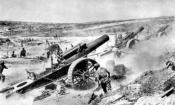
The Second World War sparked new developments in cannon technology. Among them were sabot rounds, hollow-charge projectiles, and proximity fuses, all of which were marginally significant. The proximity fuse emerged on the battlefields of Europe in late December 1944.[14] They became known as the American artillery's "Christmas present" for the German army, and were employed primarily in the Battle of the Bulge. Proximity fuses were effective against German personnel in the open, and hence were used to disperse their attacks. Also used to great effect in anti-aircraft projectiles, proximity fuses were used in both the European and Pacific Theaters of Operations, against V-1 flying bombs and kamikaze planes, respectively. Anti-tank guns were also tremendously improved during the war: in 1939, the British used primarily 2 pounder and 6 pounder guns. By the end of the war, 17 pounders had proven much more effective against German tanks, and 32 pounders had entered development.[15] Meanwhile, German tanks were continuously upgraded with better main guns, in addition to other improvements. For example, the Panzer III was originally designed with a 37 mm gun, but was mass produced with a 50 mm cannon. To counter the threat of the Russian T-34s, another, more powerful 50 mm gun was introduced, only to give way to a larger 75 mm cannon. Despite the improved guns, production of the Panzer III was ended in 1943, as the tank still could not match the T-34, and was, furthermore, being replaced by the Panzer IV and Panther tanks. In 1944, the 8.8 cm KwK 43,—and its multiple variations—entered service, used by the Wehrmacht, and was adapted to be both a tank's main gun, and the PaK 43 anti-tank gun. One of the most powerful guns to see service in World War II, it was capable of destroying any Allied tank at very long ranges.
Despite being designed to fire at trajectories with a steep angle of descent, howitzers can be fired directly, as was done by the 11th Marine Regiment at the Battle of Chosin Reservoir, during the Korean War. Two field batteries fired directly upon a battalion of Chinese infantry; the Marines were forced to brace themselves against their howitzers, as they had no time to dig them in. The Chinese infantry took heavy casualties, and were forced to retreat.
The tendency to create larger caliber cannon during the World Wars has been reversed in more recent years. The United States Army, for example, sought a lighter, more versatile howitzer, to replace their aging pieces. As it could be towed, the M198 was selected to be the successor to the World War II-era cannon used at the time, and entered service in 1979.[16] Still in use today, the M198 is, in turn, being slowly replaced by the M777 Ultralightweight howitzer, which weighs nearly half as much, and can be transported by helicopter—as opposed to the M198, which requires a C-5 or C-17 to airlift.[17] Although land-based artillery such as the M198 are powerful, long-ranged, and accurate, naval guns have not been neglected, despite being much smaller than in the past, and, in some cases, having been replaced by cruise missiles.[18] However, the Zumwalt-class destroyer's planned armament includes the Advanced Gun System (AGS), a pair of 155 mm guns, which fire the Long Range Land-Attack Projectile. The warhead, which weighs 24 pounds (11 kg), has a circular error of probability of 50 m (160 ft), and will be mounted on a rocket, to increase the effective range to 100 nmi (190 km)—a longer range than that of the Paris Gun. The AGS's barrels will be water cooled, and will be capable of firing 10 rounds per minute, per gun. The combined firepower from both turrets will give Zumwalt-class destroyers the firepower equivalent to 18 conventional M-198 howitzers.[19][20] The reason for the re-integration of cannon as a main armament in United States Navy ships is because satellite-guided munitions fired from a gun are far less expensive than a cruise missile, and are therefore a better alternative to many combat situations.
[edit] Autocannon
- Main article: Autocannon
Autocannon have an automatic firing mode, similar to that of a machine gun. They have mechanisms to automatically load their ammunition, and therefore have a faster rate of fire than artillery, often approaching—and, in the case of Gatling guns, surpassing—that of a machine gun. While there is no minimum bore for autocannon, they are usually larger than machine guns, typically 20 mm or greater since World War II.
Most nations use these rapid-fire cannon on their light vehicles, replacing a more powerful, but heavier, tank gun. A typical autocannon is the 25 mm "Bushmaster" chain gun, mounted on the LAV-25 and M2 Bradley armored vehicles.
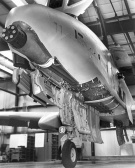
Autocannon are often found in aircraft, augmenting or even replacing traditional machine guns, while providing greater firepower. The first airborne cannon appeared in World War II, but each airplane could carry only one or two, as large bore cannon are generally heavier than machine guns, the standard armament. They were variously mounted, often in the wings, but also high on the forward fuselage, where they would fire through the propeller, or even through the propeller hub. Due both to the low number of cannon per aircraft and the lower rate of fire of cannon, machine guns continued to be used widely early in the war, as there was a greater probability of hitting enemy aircraft. However, as large cannon were more effective against more heavily armored bomber aircraft, they were eventually integrated into newer fighters, which usually carried between two and four autocannon. The Hispano-Suiza HS.404, Oerlikon 20 mm cannon, MG FF, and their numerous variants became among the most widely used autocannon in the war. Nearly all modern fighter aircraft are armed with an autocannon, and most are derived from their counterparts from the Second World War. The largest, heaviest, and most powerful airborne cannon used by the military of the United States is the GAU-8/A Avenger Gatling-type rotary cannon;[21] it is surpassed only by the specialized artillery pieces carried on the AC-130 gunship.[22]
Although capable of generating a high volume of fire, autocannon are limited by the amount of ammunition that can be carried by the weapons systems mounting them. For this reason, both the 25 mm Bushmaster and the 30 mm RARDEN are deliberately designed with relatively slow rates of fire, to extend the amount of time they can be employed on a battlefield before requiring a resupply of ammunition. The typical rate of fire of modern autocannon ranges from 90 rounds per minute, to 1,800 rounds per minute. Systems with multiple barrels—Gatling guns—can have rates of fire of several thousand rounds per minute; the fastest of these is the GSh-6-30K, which has a rate of fire of over 6,000 rounds per minute.
[edit] Operation
- Main article: Cannon operation
In the 1770s, cannon operation worked as follows: each cannon would be manned by two gunners, six soldiers, and four officers of artillery. The right gunner was to prime the piece and load it with powder, and the left gunner would fetch the powder from the magazine and be ready to fire the cannon at the officer's command. On each side of the cannon, three soldiers stood, to ram and sponge the cannon, and hold the ladle. The second soldier on the left tasked with providing 50 bullets.
Before loading, the cannon would be cleaned with a wet sponge to extinguish any smoldering material from the last shot. Fresh powder could be set off prematurely by lingering ignition sources. The powder was added, followed by wadding of paper or hay, and the ball was placed in and rammed down. After ramming the cannon would be aimed with the elevation set using a quadrant and a plummet. At 45 degrees, the ball had the utmost range: about ten times the gun's level range. Any angle above a horizontal line was called random-shot. Wet sponges were used to cool the pieces every ten or twelve rounds.
During the Napoleonic Wars, a British gun team consisted of five gunners to aim it, clean the bore with a damp sponge to quench any remaining embers before a fresh charge was introduced, and another to load the gun with a bag of powder and then the projectile. The fourth gunner pressed his thumb on the vent hole, to prevent a draught that might fan a flame. The charge loaded, the fourth would prick the bagged charge through the vent hole, and fill the vent with powder. On command, the fifth gunner would fire the piece with a slowmatch.
[edit] Deceptive simulation of cannon
- Main article: Quaker Gun
Historically, logs or poles have sometimes been used to simulate cannon, in order to mislead the enemy as to the strength of an emplacement. The "Quaker gun trick" was used by Colonel William Washington's Continentals, during the American Revolutionary War; in 1780, approximately 100 Loyalists surrendered to them, rather than face "bombardment."[23] During the American Civil War, Quaker guns were also used by the Confederates, to compensate for their shortage of artillery. The decoy cannon were painted black at the "muzzle," and positioned behind fortifications to delay Union attacks on those positions. On occasion, real gun carriages were used to complete the deception.[24]
[edit] Restoration
Cannon recovered from the sea are often extensively damaged from exposure to salt water; because of this, electrolytic reduction treatment is required to forestall the process of corrosion. The cannon is then washed in deionized water to remove the electrolyte, and is treated in tannic acid, which prevents further rust and gives the metal a bluish-black color.[25] After this process, cannon on display may be protected from oxygen and moisture by a wax sealant. A coat of polyurethane may also be painted over the wax sealant, to prevent the wax-coated cannon from attracting dust in outdoor displays.[26]
[edit] Notes
- ↑ Definition and etymology of "cannon" Webster's Dictionary
- ↑ Definition of "Gun" Merriam-Webster's Dictionary
- ↑ Aircraft cannon Dr. Carlo Kopp, Strike Publications
- ↑ Army Technology - Bradley M2/M3 - Tracked Armoured Fighting Vehicles Army Technology.com
- ↑ Gunpowder Composition for Rockets and Cannon in Arabic Military Treatises In Thirteenth and Fourteenth Centuries Ahmad Y Hassan
- ↑ Technology Transfer in the Chemical Industries Ahmad Y Hassan
- ↑ The six sizes are, in order from largest to smallest: the cannon, great culverin, bastard culverin, "legitimate" culverin, falcon, and falconet.
- ↑ They are, from largest to smallest: the cannon royal, cannon, cannon serpentine, bastard cannon, demicannon, pedrero, culverin, basilisk, demiculverin, bastard culverin, saker, minion, falcon, falconet, serpentine, and rabinet.
- ↑ Encyclopedia Britannica Online - Mortar
- ↑ The Historical Maritime Society 2001
- ↑ 12, 18, 24, 32, and 42 pounders, but 6 pounder and 68 pounder versions are known.
- ↑ Carronade The Historical Maritime Society
- ↑ Nuclear artillery United States Department of Energy
- ↑ Radio Proximity (VT) Fuzes
- ↑ British Anti-Tank Guns Jason Rahman, Avalanche Press
- ↑ M198 information Military.com
- ↑ M777 information Military.com
- ↑ Affordable precision National Defense Magazine
- ↑ DDG-1000 Zumwalt / DD(X) Multi-Mission Surface Combatant John Pike, Global Security
- ↑ Raytheon Company: Products & Services: Advanced Gun System (AGS) Raytheon, Inc.
- ↑ GAU-8/A 442nd Fighter Wing
- ↑ Information on the GAU-8/A The Language of Weaponry
- ↑ December of 1780 National Park Service
- ↑ Definitions of Civil War terms www.civilwarhome.com
- ↑ Preserving My Heritage - Before & After Gallery - Cannon Canadian Conservation Institute
- ↑ Civil War Union Cannon Conservation, CRL Report 5

